Ruttya fruticosa
Ruttya fruticosa Lindau
Family: Acanthaceae
Common names: jammy mouth, rabbit ears, bunny ears, hummingbird plant, orange bird, orange dragon, monkey face, African azalea (Eng.), jembekkie (Afr.)
Introduction
An attractive, dense, evergreen shrub with glossy light to dark green leaves, covered with an abundance of red to dark orange or yellow, two-lipped, tubular flowers with black centres, almost all year round.
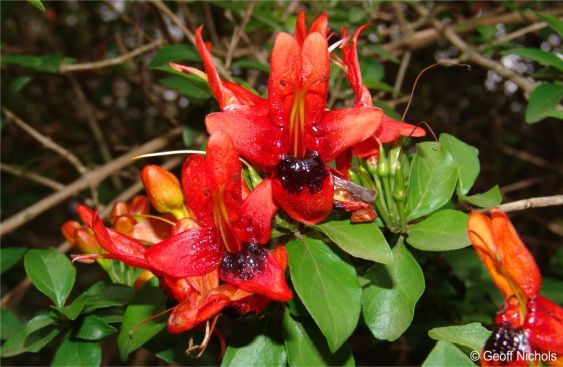
Description
Description
This hardy, multi-stemmed, rounded shrub can reach a height of 3 m. Ruttya fruticosa is a fast growing, evergreen plant with a bushy or vine-like growth habit. The bark is silverish or greyish brown, smooth with a few bumps. Leaves are glossy, dark green above and pale underneath, with a short stalk, ovate to elliptic with an acute apex, an entire margin and the midrib is visible. They are oppositely arranged along the stem. Flowers are tubular, dark orange to red, or yellow, with a shiny black centre and brown markings, carried on a stalk and held above the leaves. They are 50-70 mm long, with 2 lips, the upper lip has 2 lobes and the lower lip has 3 lobes. In the lower lip, the middle lobe curves down and forwards. These beautiful flowers are rich in nectar, and appear almost throughout the year but mainly in spring, summer and autumn.
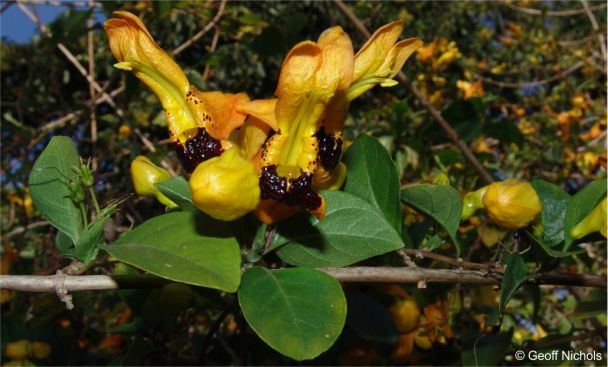
Fruits of Ruttya fruticosa are egg-shaped, brown capsules containing a maximum of 4 seeds. When the capsule is ripe, it splits open and expels the seeds so that they land far away from the parent plant.
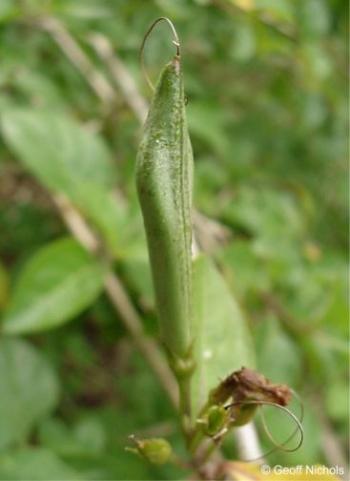
Conservation Status
Status
The conservation status for Ruttya fruticosa is not known.
Distribution and habitat
Distribution description
Ruttya fruticosa is native to East Africa. It can be found in Ethiopia, Somalia, Kenya, Tanzania, Oman, Djibouti, Uganda and Yemen, often growing in woodland. It is grown as a garden ornamental in South Africa and in many outher countries around the world.
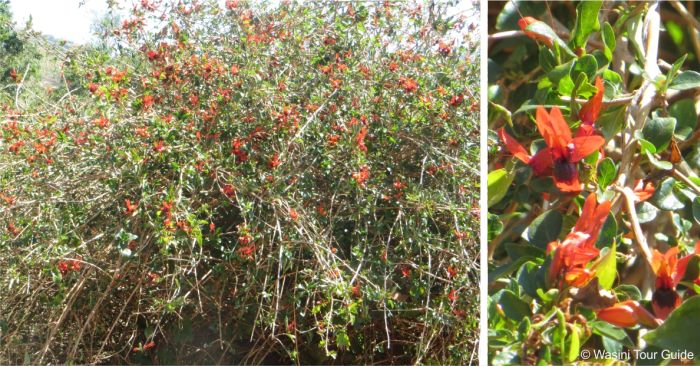
Derivation of name and historical aspects
History
This genus is named after the English physician and Irish naturalist Dr John Rutty (1697–1775). The specific epithet fruticosa is derived from Latin and means ‘bushy’, this refers to the growth habit of the plant. The common names are derived as follows: rabbit ears comes from the way the upright, 2-lobed upper petal looks like rabbit ears when viewed from the front; hummingbird plant comes from the flying-bird-like shape of the flower when viewed from the side and it attracts nectar-feeding birds like hummingbirds in America and sunbirds in Africa and Asia; jammy mouth is because of the shiny black markings at the mouth of the flower, that looks like a messy eater with blackberry jam smeared around its mouth; lava flower because the glowing red and orange colours of the flowers looks like molten lava.
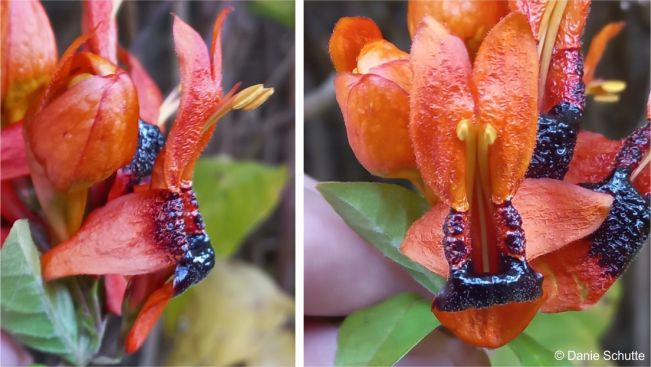
Ruttya fruticosa belongs to the Acanthaceae, a large family that contains about 250 genera and 2 500 species. The genus Ruttya consists of 6 species native to eastern and southern Africa, Madagascar and the Southern Arabian Peninsula. The only South African native species is Ruttya ovata, a scrambling shrub with dense heads of sweetly scented white flowers, that grows on forest margins and in woodland in Eastern Cape, KwaZulu-Natal, Mpumalanga and Limpopo provinces of South Africa, and in Eswatini and Mozambique. Ruttya fruticosa can be easily distinguished by its tubular, orange to red flowers with a black centres.
Ecology
Ecology
Ruttya fruticosa is a tropical plant that likes lots of warmth. The beautiful red to orange flowers are rich in nectar, which attracts pollinating insects such as butterflies, bees and nectar-feeding birds such as sunbirds. The flowers secrete fructose and glucose and are pollinated by birds. Children like to suck the sweet nectar from the flowers. Seeds of Ruttya fruticosa are dispersed when the capsule bursts open and shoots them away.
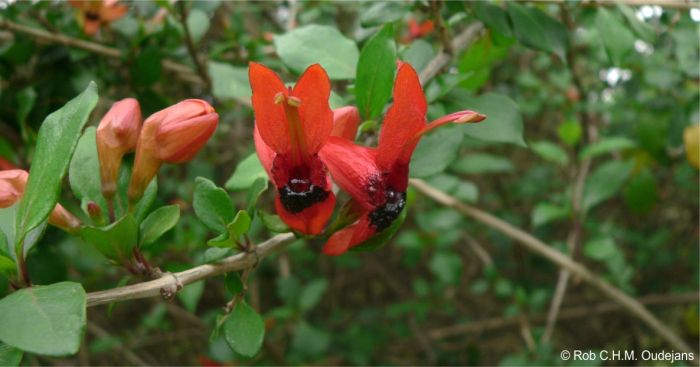
Uses
Use
Although many plants that belong in the Acanthaceae family are used as traditional medicine to treat various diseases such as skin disease, eye infection, cough, wounds, pneumonia, diarrhea and edema, there are no records of Ruttya fruticosa being used in traditional medicine. The loose long branches of are used to make kohl sticks and wedge-shaped dividers for plaiting hair. This plant is used as fodder for cattle, goats and camels.
Ruttya fruticosa is drought tolerant, semi-hardy to frost hardy shrub ,grows well in full sun or part shade, preferring a moist, well-drained slightly acidic soil. It can be used as ornamental plant in landscaping, as a windbreaker or hedge, in a water-wise garden, container plant, for cut flowers, for screening, and to attract birds and insects to the garden, and it is reputed to be important bee forage for bee keepers.
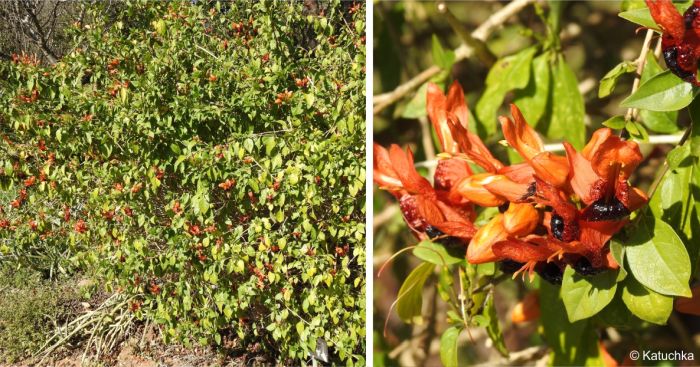
Growing Ruttya fruticosa
Grow
Ruttya fruticosa is an attractive, fast growing and easily grown ornamental plant. It is best suited in tropical and sub-tropical climates. This plant species is known to be evergreen in warm areas but in temperate climates, particularly in cold periods, it behaves as semi–deciduous, dropping its leaves which will resprout in spring. This plant species grows best in well–drained, slightly acidic soil with little bit of added compost, in rocky areas, in full sun or partly shaded. It can tolerate short periods of drought and is semi-hardy to frost. It should be watered twice per week and fertilized with an organic fertilizer twice per year. Pruning should be done in late winter, after flowering, to encourage new growth and in summer, to give a more compact shape and to keep it tidy. Its roots system is not aggressive, it can be planted near paving or foundations.
This beautiful shrub is a very good choice in smaller gardens. It is suitable to use for screening, as an informal hedge, as a windbreaker and can be planted in a container. It is also specifically planted in the garden to attract birds, bees and butterflies. Ruttya fruticosa looks good when planted together with Plumbago auriculata, the beautiful blue blooms make a pleasing colour combination with its reddish orange flowers.
This plant species is most likely to be infected by leaf-yellowing diseases which is caused by insufficient of essential nutrients, caused by both overwatering and underwatering. The leaves are subjected to attack by Aphid and Whitefly which feed on the leaves. Pesticides should be used to control the pests.
The beautiful jammy mouth plant can be propagated by stem cuttings or seeds. Cuttings should be placed in a mist house on raised beds with bottom-heating cables. Washed river sand is the best medium for growing Ruttya fruticosa cuttings. Propagate cuttings in spring. Take cuttings in the morning, use a sharp knife or secateur to reduce injury to the parent plant, place the cuttings in a plastic bag immediately after harvesting to avoid water loss, remove the lower leaves but leave the top two or three, cut stems just below a bud, apply rooting hormone to the bottom end of the cutting, use a dibber stick to make holes in the soil medium, the holes should be larger than the cuttings so that the rooting hormone is not rubbed off when the cutting is placed in the medium. Stick the cutting in to the growth media, gently press the medium around the cutting. Water the cuttings.
Ruttya fruticosa seeds should be sown in spring. Seeds should be removed from the capsule. Prepare the soil by mixing 1 part of washed river sand with 3 parts of potting soil, fill the seed tray with the growing media and firm it down, space the seeds evenly, cover the seeds with a thin layer of growth medium. Water the seed tray thoroughly and place the seed tray in a germination house. Germination will start after 3 weeks. Seedlings should be pricked out and transplanted when they are 5-8 cm tall and have 2 true leaves. Seedlings should be hardened off for 2 weeks. This plant species can be planted in the garden when it is 1 m tall.
References
- Blogging in Myrtle Glen. Too many names. https://www.myrtleglen.com/2012/08/too-many-names.html. Accessed 27 May 24.
- Hedrén, M. & Thulin, M. 2000. Ruttya fruticosa Lindau. Flora of Somalia. Accessed via JSTOR Global Plants. https://plants.jstor.org.
- India Biodiversity Portal. Ruttya fruticosa Lindau. https://indiabiodiversity.org/observation/show/18610304. Accessed 27 May 24.
- Katuchka. 2023-06. Observation of Ruttya fruticosa, Lowveld National Botanical Garden, Mpumalanga. iNaturalist. Online. https://www.inaturalist.org/observations/167757047.
- Khan, I., Jan, S.A., Shiwari, Z.K., Ali, M., Khan, Y. & Kumar, T. 2017. Ethnobotany and medicinal uses of folklore medicinal plants belonging to family Acanthaceae: an updated review. MOJ Biology and Medicine 1(2):34-38.
- Latti, I. n.d. https://www.operationwildflower.net/index.php/albums/30-types/14-shrubs/205-ruttya-fruticosa-205. Accessed 27 May 24.
- Life is a garden. Jammymouth (Rutty fruticosa). https://www.lifeisagarden.co.za/jammymouth-rutty-fruticosa/. Accessed 27 May 24.
- Makholela, T., et al. n.d. Red Data assessment, allozyme diversity, reproductive biology and management strategies in populations of a rare and restricted species, Barleria greenii (Acanthaceae). https://wiredspace.wits.ac.za.
- Oudejans, R.C.H.M. 2009-10. Observation of Ruttya fruticosa, Vaalwater, Limpopo. iNaturalist. Online. https://www.inaturalist.org/observations/38456961.
- Plants of the World Online. Ruttya fruticosa Lindau. https://powo.science.kew.org/taxon/urn:lsid:ipni.org:names:54838-1#publications. Accessed 27 May 24.
- Pooley, E. 1998. A field guide to wild flowers of Kwazulu-Natal and the eastern region. Natal Flora Publications Trust, Durban.
- Random Harvest. Ruttya fruticosa. https://www.randomharvest.co.za/South-African-Indigenous-Plants/Show-Plant/PlantId/186/Plant/Ruttya-fruticosa. Accessed 27 May 24.
- Schutte, D. 2023-06. Observation of Ruttya fruticosa, University of Pretoria, Hatfield Campus, Gauteng. iNaturalist. Online. https://www.inaturalist.org/observations/169946877.
- The Blanchard Community Forest. Ruttya futicosa. https://sites.google.com/designcounts.org/isk-community-forest/indigenous-shrubs/ruttya-fruticosa. Accessed 27 May 24.
- The National Gardening Association Plants Database. Hummingbird Plant (Ruttya fruticosa). https://garden.org/plants/view/115787/Hummingbird-Plant-Ruttya-fruticosa/. Accessed 27 May 24.
- Wasini Tour Guide. 2020-08. Observation of Ruttya fruticosa, Tsavo West , Kenya. iNaturalist. Online. https://www.inaturalist.org/observations/101875996.
- Wikipedia. Ruttya fruticosa. https://en.wikipedia.org/wiki/Ruttya_fruticosa. Accessed 27 May 24.
Credits
Winfred Ngwenya
Lowveld National Botanical Garden
July 2024
Acknowledgements: images by Geoff Nichols, Wasini Tour Guide, Danie Schutte, Rob Oudejans and Katuchka.
Plant Attributes:
Plant Type: Scrambler, Shrub
SA Distribution:
Soil type: Loam
Flowering season: Spring, Early Summer, Late Summer, Autumn, Winter
PH: Acid, Neutral
Flower colour: Black, Red, Yellow, Orange
Aspect: Full Sun, Morning Sun (Semi Shade), Afternoon Sun (Semi Shade)
Gardening skill: Easy
Special Features:
Horticultural zones









Rate this article
Article well written and informative
Rate this plant
Is this an interesting plant?
Login to add your Comment
Back to topNot registered yet? Click here to register.